GRASS
Geographic Resources Analysis Support System, commonly known as GRASS, is an open source, free GIS software with many modules for raster and vector data manipulation, multispectral image geocoding and processing and attribute management. GRASS is developed in a UNIX environment and is supported by Windows, MacOS X, Linux.

The important features of GRASS includes Raster analysis, 3D-Raster (voxel) analysis, Vector analysis, Point data analysis, DTM-Analysis, SQL-support. Other modules like Erosion modelling, Landscape structure analysis, Solution transport, Watershed analysis arae also integrated with this software. www.grass.itc.it
ILWIS
The Integrated Land and Water Information System (ILWIS) is a PC-based GIS and Remote Sensing software, developed by ITC up to its last release (version 3.3) in 2005. As per July 1st, 2007, ILWIS software is freely available (‘as-is’ and free of charge) as open source software (binaries and source code) under the 52°North initiative (GPL license).

ILWIS comprises a complete package of image processing, spatial analysis and digital mapping. Key features include integrated raster and vector design, import and export of widely used data formats, along with a comprehensive set of image processing tools, advanced modeling and spatial data analysis, 3D visualization with interactive editing for optimal view findings. The system also has a rich projection and coordinate system library with modules for Geo-statisitical analyses www.itc.nl/ilwis
JUMP GIS
The JUMP Unified Mapping Platform (JUMP) is a GUI-based application for viewing and processing spatial data. It includes many functions common to other GIS products for the analysis and manipulation of geospatial data. The JUMP also provides a highly extensible framework for the development and execution of custom spatial data processing applications.

The JUMP offers features like interactive workbench for viewing, editing, and processing spatial data, API providing full programmatic access to all functions, including I/O, feature-based datasets, visualization, and all spatial operations. Also the software supports major industry standards such as GML and the OpenGIS Consortium’s Spatial Object Model.
The JUMP provides APIs for all of its core classes. This allows spatial functionality to be easily incorporated in other standalone Java applications. The set of core APIs includes Feature API ,I/O API for Reading and Writing of spatial data formats such as WKT, GML, and ESRI Shapefile, Warping API and the WMS Client API which gives the software, ability to retrieve capabilities of WMS server, formulate map requests and retrieve map images. www.jump-project.org
MapWindow GIS
MapWindow is an open source mapping tool, a GIS modeling system, and a GIS application programming interface (API) all in one convenient redistributable open source form. MapWindow is more than just a data viewer, and it is extensible through custom plug-ins to add additional functionalities.

At the core of the MapWindow application is the Map- WinGIS ActiveX control. Using this control, you can program custom mapping functionali- ty. MapWindow includes standard GIS data visualization features as well as DBF attribute table editing, shapefile editing, and grid importing and conversion. www.mapwindow.org
SAGA GIS
SAGA – System for Automated Geoscientific Analysesis a hybrid GIS software. SAGA is written in the C++ programming language and follows an object oriented approach. The objective of SAGA is to give geoscientists an effective platform for the implementation of geoscientific methods, which is achieved by SAGA’s API’s. SAGA’s true strength lies in the fast growing set of geoscientifc methods, bundled in exchangeable Module Libraries.

www.saga-gis.uni-goettingen.de
uDig
uDig is both a GeoSpatial application and a platform through which developers can create new, derived applications. uDig has been designed from the start as a general purpose development platform that is completely scalable and customizable and it can handle the largest data sets; and can be completely integrated with standard internet data sources such as OGC WMS and WFS. It has a coordinate reference system support for all data sources, and on-the-fly coordinate system integration and supports ESRI Shape files, PostGIS, DB2, Oracle Spatial formats. Another important functionalility is the extensive standards support (OGC Filter, OGC Spatial Reference System, OGC Styled Layers, etc). udig.refractions.net

The list mentioned here is subjective and not exhaustive as these are few software that maintains OGC standards and have an active user community. Other software like deegree, QGIS and gvSIG have been mentioned in detail in this issue. Supresoft ad







